The 4-4-2 System of play
In the modern game, we have seen various tactical shifts, especially in the past 20 years.
In the mid-90s, playing in a flat 4-4-2 was a common theme across Europe. The wingers would move high, midfielders would both be box-box and make sure one sat while another roamed forward, while Full backs would support the wingers on the outside, focussing mainly on wide attacks, crosses into the box and generally direct play, which often left teams weak in defensive transition and teams would use this to sit in a low block and use counter attacks from crosses as a way to create scoring chances.
Until 2014, 4-4-2 was a rare system in successful teams, until Atletico Madrid won La Liga using a strong defensive system, based on rapid transitional attacks and playing often with less than 40% possession.
As a method of understanding how organised our shape, we can line the field in a way to show positional zones behind the play, vertically and horizontally. Often this can be for attacking organisation, defensive organisation, recovery runs or pressing layers.
Possession play v the 4-4-2; The rise of 4-3-3 and evolution of the 4-2-3-1
When the old 4-4-2 was used in possession, they would find it difficult to control play in the centre by virtue of having a player less in this zone, so either a CF would have to drop deep or play with a winger inside to create superiority. As a consequence, other players would have to make compensations within their own roles to help fill the spaces which appeared in all phases; offensive, transitional and defensive.
Teams started to shift into starting positions with the extra midfielder, often in a flexible 4-3-3 to add an extra player to gain control of the centre to create positional superiority and control the game. As teams using the 4-4-2 would usually play the CFs against the CBs, and the 2 CMs 1v1, this left a DM (number 4 or 6) as the free player, able to dictate play from deep, and push the wingers higher to open space in deeper areas for the FB to move into vertically, or the CM to move into laterally or diagonally.
A reaction to that was to play a different shape against the more commonly used 4-3-3, to counter the 3v2 in midfield, it was sensible to play 3v3. To do this, many coaches adopted the 4-2-3-1 to play 3v3 and match up all over the field to mirror the triangle in midfield.
The advantages of playing a modified 4-4-2 (4-2-3-1) with higher wingers, a deeper CF and deeper CMs was the additional layer of compactness (the number of lines vertically from Defence, midfield, front) as 4-2-3-1 has 4 lines when starting while 4-4-2 only has 3. Having the deeper CF in the same zone as the number 4/6 of the opponent who would dictate play, reduced the influence of this player and allowed the wingers to push higher to prevent the FBs from gaining possession under little pressure as the running distance to press was reduced.
Partnerships and attacking in a 4-4-2
One of the main strengths is that everyone has at least 2 partners, for example the RB will have the RM and RCB as partners, with the RCM also able to come into the zone and help in both attack and defence.
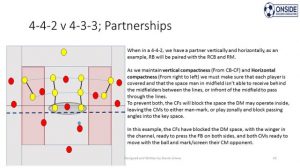
In possession, Players could play vertically and direct by using the CF v CB 1v1 battle to play direct and start attacking from the opposition half. Often if there was high pressure, the defence would have an option to by-pass the opposition midfield press with direct vertical passing into the front 4. If play broke down very often, this would lead to ‘broken’ and ‘disorganised’ matches where no team has control and this example is often indicative of Scottish football. Often, when teams attacked, they would attack direct, or wide from crosses. Lots of them. A big problem with basing your game on crosses is inefficiency and imbalance in transition from loose balls.

As a method of preventing counter attacking when playing in a wide 4-4-2 and making lots of crosses, Pep Guardiola used a 4-4-2/4-2-3-1 using Thomas Muller as a 2nd striker attacking from wide/deep, with FBs Lahm and Alaba in narrow positions to be more stable behind the ball and allow better positioning across multiple layers to press the counter attack (counter pressing). From narrow positions, they were more secure to win the ball back quickly and re-start the next attack. Playing too wide prevents this possibility and makes it much easier to be exposed against a team playing often in transition phases.
Weaknesses in the 4-4-2: vertical compactness when pressing high
As the front block of 6 players press high, often the defensive line may be unable to keep moving up, so the space between midfield and defence can be exploited leaving the back 4 having to run backwards and prevent penetration or an attack on goal. Pressing high with a holding midfielder provides more stability, which is another reason why 4-3-3 or 4-2-3-1 has become more in favour than a 4-4-2.
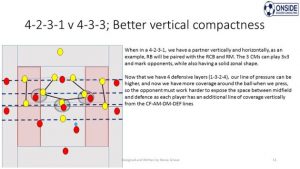
4-4-2; A Scottish obsession?
Here’s a scenario we often see. A team are 1-0 down, or 0-0 and expected to win. They are relatively in control of the match. The masses are impatient. The coach is implored to make a decision to try to find a way to score and get the fans back onside and behind the team.
“Get 2 up there”, “Just git it up the park”, “Less of that tippy-tappy stuff”, or my favourite “2 attackers is more attacking than 1”. Control in transition is often not considered here.
How often do we hear these comments, then if they don’t score, that’s the only reason they didn’t win?
Often in Scotland, the general perception is playing with 2 Centre Forwards isn’t attacking enough despite some teams often playing 4-3-3 and having a 2-1-4-3 with 3 centre forwards and having more CFs than in a flat 4-4-2. Crosses and long diagonals are also a must despite the inefficiency in most cases.
In the modern game, some teams have played a modified 4-4-2 and had success. Atletico Madrid, Leicester City, Bayer Leverkusen, Red Bull Salzberg, Villarreal and Red Bull Leipzig some notable teams.
The difference between those teams and the way a Scottish 4-4-2 is perceived to be implemented; all of these clubs played a very transitional style based around a solid defensive base, except Villarreal who are a controlled possession team playing a 2-4-2-2 basing the system on 2 deep midfielders to control play from the build-up phase, and quick vertical passes from deep to run behind 3rd man via FBs or wingers running between FB and CB in an interesting style creating 4v3 or 5v3 in midfield.
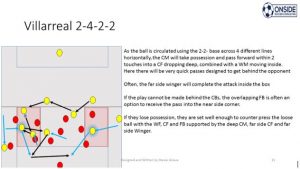
This is a very intricate version of a 4-4-2, and very far away from the old version of playing the ball in the air and hoping for some luck with 2nd balls. To me, this is the best way to play a direct 4-4-2, playing into feet to draw players out of position and use 3rd man runners to attack the space behind the defence.
The modern 4-4-2; a system to dominate the transitional game?
As we can expect to be playing a direct game in a 4-4-2, we know that we will likely have to defend often in transition; counter pressing, defending counter attacks, recovery runs, re-starting play from a long run, then organising play to re-start our attack, knowing when we lose the ball we start our transitional cycle again.
Knowing and accepting you will often be in transitional game cycles, it makes sense to understand how best to organise this part of the game and use it to your advantage.
Our attacking structure will allow us to play ‘inside the block’ to open up the wide areas for Full Backs, with the wingers now central attacking midfielders in channel positions, supporting the strikers. It could look like a 4-2-3-1 or 2-2-4-2 quite often but the formation is less important than the occupation of specific spaces inside the opponents defensive block, and the ability to play 1 touch in small spaces.
Once possession is lost, we know we can press quickly from multiple angles over multiple defensive layers, forcing play wide. Once the ball is regained, we take advantage of the dis-organisation of the opponent and try to get behind the defence into the space as quickly as possible.


Each pressing zone is organised to block 3 exits, and force into an area where we defend in small spaces. The further form the ball the layer is, the more space needs to be defended. It is important we win the ball very close to the turnover and run into the gaps between the back 4 to look for passes behind
Defending in a 4-4-2: Atletico Madrid and Bayer Leverkusen offer the template for success
Defensively, the 4-4-2 has many advantages by being able to engage in 1v1 pressing higher up the field with a solid structure around the ball. In a high pressing system, the far side winger can press circulation to make the shape look like a 3-4-3, while the near side winger can press high and make the shape look like 4-3-3 or 3-4-3 if the FB jumps onto the midfield line behind them.
Bayern Leverkusen are a team who have used the 4-4-2 as a fantastic zonal pressing mechanism to control central space, and create wide pressing traps to regain possession in the wide zone via the FB, WM, CM and CF, looking to play quickly behind the defense in transition very quickly, similar to Leipzig in design, willing to take the risk of being caught offside or the attack breaking down due to the chaotic nature of the 1 touch play.
If we assess a team playing in a low block in a 4-4-2, Atletico Madrid provide the template for success. They would identify exactly how to play against different opponents adjust the width and height of the block, prevent access to the centre in many cases via the deep and central positioning of the 2 CFs who move wide and create good diagonal compactness when the ball enters a wide zone (ie LB, LW, LCF) with cover in the spaces behind the 3 from the far side CF and near side CM.
When they shift from wide to side, often the far side players will move up a line to block the space upon circulation, while the near side CM drops very deep to screen the CBs, discouraging forward passes and delaying the forward play of the opponent.
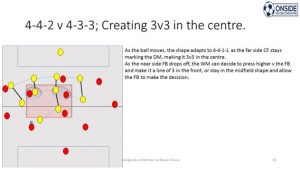
Often, when possession is won, they will play with quick 1 or 2 touch aggressive actions, playing direct with highly scripted movements which are coached in a very specific manner. Runners run between players on the defensive line, hoping to overload 3v2 in the centre to draw open an easy pass wide if the centre is blocked off, which can often lead to a pass across the 6 yard line to score.
They will lock down the centre of the field and make it impossible to be played through without quick 1-touch play and dribbles past opponents to create space

Far side CF blocks DM, WMs block diagonal pass, sets pressing trap on FB. CMs 1v1 in centre.

Arced midfield line to prevent diagonal penetration from here to Neymar or Iniesta drifting behind. FB out pressing WF, CFs blocking re-start and circulation passes.
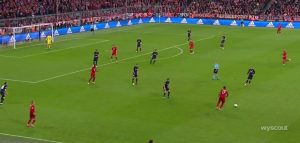
Atletico blocking the centre, FBs wide to defend 1v1, WMs block channel pass. CMs screen CBs. CF blocks circulation. Far side CM ready to press next pass to force back to pressure area (out of shot)
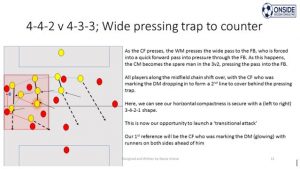
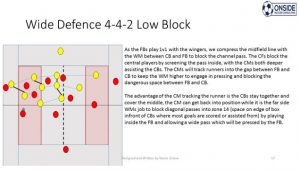
Tactical Priorities in the 4-4-2?
The first thing we need to ensure when playing in a 4-4-2 is that defensively we are not overloaded in the centre, which was a big problem against teams playing a 4-3-3 against a 4-4-2 and able to use the extra player either infront of or behind the central midfielders. To protect this space, we can compress the 2 centre forwards against the space of the DM leaving the CBs free to pass, which means we will ‘block the space then press the pass’.
If we drop the CFs deep, our line of pressure is deeper than we might prefer but it is balanced by being able to create a 4 v 3 in central midfield or mark the DM when we press the wide pass and stay equal centrally.
Once we know we will not be overloaded centrally, we must use the wide zone as our pressing players are the CF, WM CM, and FB. When the WM and FB press 2v2, we need to create a free man to press the pass 2v1 at the FB. This will be how we win the ball back using the CF to cover inside the FB.
From winning the ball back, we must already know how we will exit; will we go direct vertically, will we exit diagonally, will we switch play to attack the other side, or will we re-start play to provoke pressure to create spaces in the middle to pass through, or will we simply re-start play and play from an organised possession shape?
With all of these questions, we must know:
- Do our player profiles fit how we want to approach the game?
- Does our positional structure allow us to play in possession how we want?
- Will the players have the determination to win races in transition to get behind the opponent?
Possible playing philosophy?
This, like all ‘formations’ is dependent on what the players are able to do, what they understand, what the previous habits were from the previous coaching staff, and the way you design, deliver and analyse both training sessions and matches.
Philosophy serves as a guide for the way you think and see things in all aspects of life. It provides a template for the decisions you will make based on the beliefs and identity of you as a person.
With this in mind, any style of play can be taught within any shape. Formation is only a starting point as as Julian Nagelsmann recently said “You might find that you are in exactly your formation 8 times per match”. Whether this is true or not is up for debate but when we assess a match, the formation allows for specific positioning and coverage of space. It is how we move as a collective unit which defines the playing philosophy.
If we break the game into 3 distinct game cycles:
Attacking
- Build up from GK
- Ball movement patterns
- positional structure
- player movement patterns
- penetration of the opponents defensive lines
- chance creation
Transitioning
- Loss of possession, counter pressing, recovery runs, regain of possession à Attacking phase
- Or
- Loss of possession, recovery into defensive block, provoke bad decision/execution à regain possession
- Regain of possession, transition passes àre-start play from deep (v transitional team) or
- Regain of possession, transition passes à creating attacking phase, attack space at speed, Quick passes
- We can include periods of multi-transitions, for example
- Counter attack, lose the ball, counter press, regain the ball, counter attack, MISS, counter press.
Defending
- Organised defensive shape
- Dynamic defensive shape
- Tracking runners
- Defending key spaces
- Fighting for space
- Suffering stress
- Identifying regain zones
- Starting counter attacks
If the Scottish 4-4-2 is to stay alive in the modern era, we must rid ourselves of the ‘play direct to the big man’ mentality.
The 4-4-2 is a very effective defensive shape, allowing many opportunities to play aggressively in transition moments. This is where the 4-4-2 is best utilised in the modern game.
Bayer Leverkusen, Atletico Madrid and RB Salzburg are showing the template for an effective 4-4-2 in the modern game. Defensively solid, tactically astute, lightning quick in transition moments.
The build-up phase and penetration phases when the opponent are in a low block mean that in the old, tired, Scottish 4-4-2, the wide players making many vertical runs which are easy to defend against must be evolved into more diagonal, considered based on opposition positioning specific movements to find a way to move forward in the modern game and ensure that the next generation of players can go further than our previous failed generations.
To help implement our game model which is within our playing philosophy; ie
- Control of possession
- Positioning inside the block
- Penetration to create chances centrally
- Using the FBs as wall players to release pressure
- Using the FBs as ‘protection’ in possession if we have wingers with the advantage in 1v1 quality.
- Using the CMs to control the space behind the 1st layer of pressing
- Retaining compactness in a low block
- Speed and accuracy in our positioning during recovery running phases



